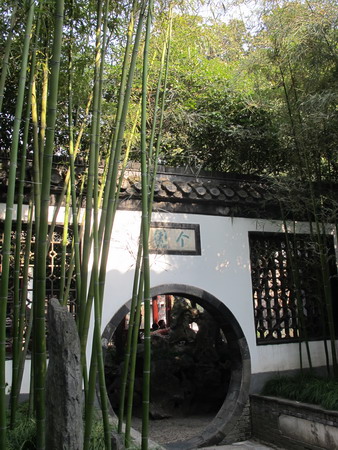Photos
Yangzhou's most famous garden parties
Updated: 2011-01-30 15:33
By Han Bingbin (China Daily)
|
 |
|
The Bamboo Garden, built in 1818, is famous for its creative landscaping with slender bamboo. [Photo / China Daily] |
The same can be said of Jiangnan, the region covering Jiangsu and Zhejiang provinces that has long been known as a playground for princes and poets, and a recognized repository of rich assets and cultural heritage.
But Yangzhou's connection to Jiangnan is constantly challenged by experts who argue on a geographical technicality.
That is because Yangzhou is located to the north of Yangtze River.
Linguistically, the city is also different from the rest of Jiangsu and Zhejiang in that it does not speak the Wu dialect, generally considered the lingua franca of the Jiangnan region.
Politically, too, present-day Yangzhou is only a fraction of the size of its ancient namesake, a spreading region south of the Yangtze that earned it the link.
But these debates have no effect on local pride, which does not doubt that Yangzhou will continue to command a strategic position in the Jiangnan tableau, a confidence borne by the testimony of the many poets and scholars who have sung the city's praises throughout history as a gem in the southern diadem.
More tangible proof comes in the ancient but well-preserved Yangzhou classical gardens - all landscaped according to the Jiangnan style.
Just as Beijing guarded its position as the seat of government through the dynasties, Yangzhou had cloistered generations of the mercantile rich who chose to settle in this corner of paradise.
At one time, the city boasted more than 200 intricately landscaped private gardens, a number that has been reduced by the turbulence of the ages to just under 30.
The most well-preserved among these are Slender West Lake, the Bamboo Garden and He Garden.
Named for its beautiful visages comparable to Hangzhou's West Lake, the Slender West Lake is so named for its slimmer contours. It was built by local governors and salt traders during the Qing Dynasty when emperor Qianlong traveled to the city. Known for its 24 scenic spots along the water, the Slender West Lake is a comprehensive expression of classical Chinese landscaping, and is now recognized as one of the country's key scenic spots.
| ||||
Although they are smaller than the Slender West Lake, they made up the lack with magnificence in design and layout.
Mostly built in middle and late Qing Dynasty near the end-days of Imperial rule, Yangzhou gardens have less of the peaceful and quiet spirit characterized by the classical gardens of Suzhou. In Yangzhou, the gardens were built for entertaining.
Suzhou gardens were mainly created by the leaders of literature who often retired in solitude to landscaped retreats after failing in politics. Most of the Yangzhou gardens were built by wealthy salt traders who used the magnificence of their gardens to flaunt their wealth, identity and vanity.
Many of these traders came from good families and were known as "Confucian entrepreneurs", former intellectuals who had turned to commerce. Their literary leanings were influenced by their mercantile success.
So, while Suzhou garden preferred subtle water features, Yangzhou gardens went for big bodies of water - like the Slender West Lake - embellishing them with complex nine-turn lacquered bridges and gilt-topped pavilions.
E-paper

Ear We Go
China and the world set to embrace the merciful, peaceful year of rabbit
Preview of the coming issue
Carrefour finds the going tough in China
Maid to Order
Specials

Mysteries written in blood
Historical records and Caucasian features of locals suggest link with Roman Empire.

Winning Charm
Coastal Yantai banks on little things that matter to grow

New rules to hit property market
The State Council launched a new round of measures to rein in property prices.




